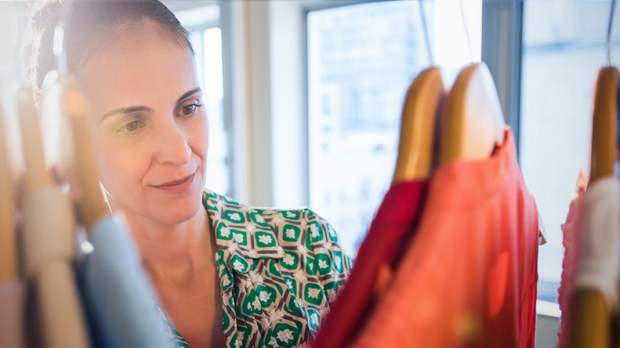Sometimes it seems like we women are the most unsatisfied beings on the planet. If we have curly hair, we want straight hair; if it’s straight, we want curls. Thin women want more curves; curvy women want to be thinner. I could go on and on with examples of how the grass always seems to be greener on the other side.
Clothing, of course — something essential for the great majority of us, which can bring us to the border of a breakdown when we have to choose what to wear in the morning — might be one of the top things we struggle to be happy with.
And it starts early: Every day, it feels more common to see little girls wanting to wear high heels, makeup, and tight clothing (to say nothing of teenage girls just coming of age, who ask for plastic surgery); as well as older women still donning miniskirts, hair extensions, and incredibly low necklines. And while there are issues with both groups, it is on this later trend that I want to focus, because — let’s be honest — Heidi Klum’s sensational legs at age 43 are very much the exception.

Read more:
Bras and Authentic Beauty
A short time ago, I ran across an article in which Venezuelan designer Carolina Herrera, the epitome of elegance, talked about the relationship between fashion and beauty, declaring, “Nothing makes a woman look older than dressing as if she were younger.”
I couldn’t agree more with this pithy observation. When a 60-year-old woman wears an animal print miniskirt while tottering around on incredibly high platform sandals, the focus is going to be on her age, highlighted by her superficial physical appearance. By contrast, if that same woman were to wear a jewel-toned a-line skirt with a beautiful silk blouse and neutral-colored stilettos with a medium heel, the outfit would highlight a sophisticated style as well as the woman behind the clothes. (Think of Jane Fonda’s wardrobe in the otherwise ridiculous movie Monster-in-Law. Does she have an amazingly toned body for a 70 year old? Yes, indeed. But she isn’t wearing tube tops and tight dresses like her younger counterpart, J-Lo.)
Often, I think the problem is that we forget that there is a lovely option in between over-the-top youthful clothing and old-school grandma, baking cookies and doing needlepoint in full-coverage floral dresses, glasses on a chain, and sweaters with antique pins on them (not that there’s anything wrong with that, but I also understand not wanting to adopt that particular granny look at a youthful-feeling age of 60, either).
But it’s easy to forget that there’s a middle ground because we’re so panicked by age itself. And that begs a bigger question: Why are we all so afraid of not looking young?
Well, some fashion history buffs credit the 1960s with ushering in a wave of clothing that showed off youthful bodies: bell-bottoms and crop tops, trends that couldn’t be worn by just anyone, and therefore linking the fashion forward with lean figures. (Compare that with the 1950s, when trendy clothing like a poodle skirt was appropriate for a wide range of ages.)
Later on, the Baby Boomer phenomenon came along, which resulted in a sort of “dominance of youth.” There were more young people to design for, so more stores catered to them.
But an important part was also played by the influence of media: TV, movies, billboards and women’s magazines, which depicted young, svelte women as the reference point for beauty, and a constant bombardment of products for hiding wrinkles.

Read more:
Finally! A beauty company that isn’t trying to ‘anti-age’ us
Those beauty ideals have become so embedded in our culture that even today, when most of us know better, we’re still praising youth. It’s not wonder we feel pressure to dress younger. Especially when coupled with the fact that most of us at age 40, 50, 60 and 70 still feel younger. And by taking care of our bodies with better nutrition and exercise, we look and act younger than ever before, too. So, understandably, we’d rather not be labeled an “old lady” just yet.
Still, there’s a crucial difference between dressing in a way that makes you look younger, and dressing as if you were younger. Just as there are clothes for all body types, there are also clothes for all ages, and every day there are more options on the market to help us look fabulous (rather than foolish) at any age.
But first, a little quiz to see where you lie on the spectrum of youthful fashion: Here are five things that will easily determine if you’re falling into the trap of not dressing for your age:
1. If you keep buying exclusively in a store for adolescents or 20-year-old girls (if you’re wondering about H&M, don’t worry; they continue to offer options for all ages, just be discriminatory as you peruse the racks, but Forever 21 is worth pausing over).
2. If you’re on the street but showing enough skin to be on the beach.
3. If you keep dressing exactly the same way you did 10 years ago. Are you still wearing that skirt from freshman year of college at age 35? It’s time for a change.
4. If you have t-shirts with cartoons or “funny” phrases on them. Just trust me on this one.
5. If your only reference points for fashion are models 25 years old or younger.(If you are 50 years old or more, I recommend you follow @journeyofastylist on Instagram; in general, she gets it right and has fantastic fashion sense).
I am 30 years old, and often feel like I’m on the border between two generations, but I try to embrace my age, rather than attempt to dial it backward. Every decade of our lives is full of different and marvelous things that require different kinds of clothes.
The key to looking good according to your age isn’t just in understanding who you are, but also in knowing what kind of image of a woman you want to project.
When you start feeling the pressures of youth, just remember Jane Fonda, or actress Helen Mirren, who always looks glamorous on the red carpet, or Isabel Preysler, the Spanish socialite. All of these women are older than 60, and although they follow major fashion trends, they have the wisdom to adapt the trends to their age and dismiss those that are simply for a younger body.
We have to ditch the mentality that sees aging as negative, and instead, appreciate the good that comes with the passing of years: economic independence, more experience, more confidence, eating better cuisine, staying in nicer hotels … and dressing fabulously for it all!
This article was originally published in the Spanish edition of Aleteia.

